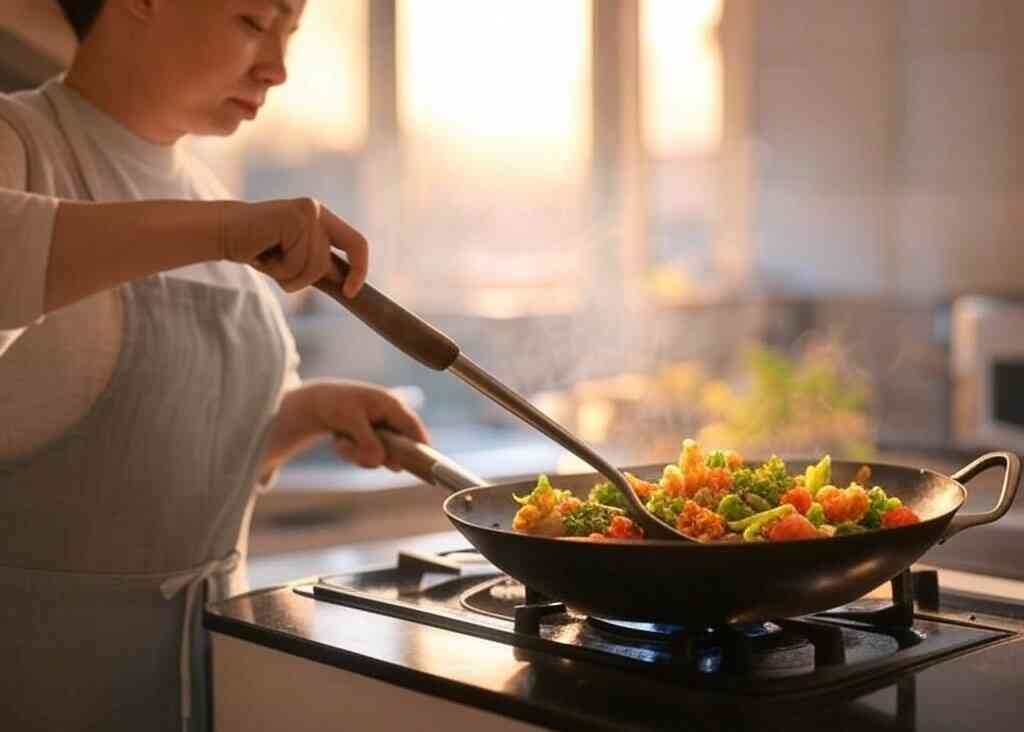Introduction to Wok Materials
The wok, an essential cooking vessel in many Asian cuisines, is celebrated for its versatility and effectiveness in stir-frying, steaming, and deep-frying. While carbon steel woks have earned a reputation for excellent heat retention and responsiveness, various materials can significantly enhance the cooking experience. Understanding the unique properties of these materials is vital for selecting the right wok. This choice should align with one’s personal cooking style and preferences.
Cast iron woks are known for their superior heat retention. This makes them ideal for achieving consistent, evenly cooked meals. They can maintain high temperatures for longer periods. This can be particularly beneficial for deep-frying and slow cooking. However, cast iron requires special care. It is prone to rusting if not properly seasoned and maintained. Those who appreciate traditional cooking aspects may find a cast iron wok appealing.
On the other hand, stainless steel woks offer durability. They also resist rust and staining. This makes them a practical option for everyday cooking. They do not react with acidic ingredients. Thus, they ensure the integrity of the dish’s flavor. Although they may not conduct heat as effectively as carbon steel, advancements in technology have enhanced their performance in heat distribution. These advancements include the incorporation of aluminum cores.
Aluminum woks are lightweight. They offer excellent thermal conductivity. This provides quick heating and cooling. They are particularly useful for high-heat techniques like stir-frying. Like stainless steel, they resist rust and are easy to clean. However, they can be prone to warping and scratching. Ultimately, each material presents its own unique advantages. So, selecting the right one depends on the individual cook’s techniques and culinary goals.
Cast Iron Woks: The Hearty Option
Cast iron woks are renowned for their remarkable heat retention and even cooking capabilities. This makes them a solid choice for various culinary tasks. Unlike traditional woks made of carbon steel, cast iron woks provide superior insulation. This allows them to maintain a consistent cooking temperature. This quality is particularly beneficial when preparing dishes that require gentle cooking. Examples include stir-fries and braises. This ensures that ingredients cook evenly without hot spots.
The robust construction of cast iron woks also makes them ideal for deep-frying. Their thick walls provide excellent heat retention. This is critical in maintaining oil temperature when frying foods like battered shrimp or crispy vegetables. The even distribution of heat ensures that items cook uniformly. They also achieve the desired texture without absorbing excess oil.
For slow-cooking operations, cast iron woks excel. They allow the gradual melding of flavors. This makes them perfect for stews or rich sauces. The material’s ability to hold onto heat means that dishes cooked within retain their warmth long after removal from the heat source. This makes cast iron woks not just functional but also practical for serving meals straight to the table.
To ensure longevity, proper care for a cast iron wok is essential. The seasoning process forms a protective layer. This helps maintain the wok’s non-stick properties. It also improves flavor and prevents rust. It usually involves applying a thin layer of vegetable oil. Then, heat the wok to create a polymerized surface. Additionally, cleaning must be done carefully. It is advisable to avoid soap or abrasive materials. These can strip the seasoning. Instead, lightly scrub with hot water and a stiff brush. Follow this with thorough drying to preserve its condition.
Overall, the hearty nature and versatile uses of cast iron woks make them a valuable addition to any kitchen. They offer distinct advantages for various cooking methods.
Stainless Steel Woks: Durability and Versatility
Stainless steel woks are a popular choice among both home cooks and professionals. This is due to their exceptional durability and versatility. Made from an iron alloy that includes chromium, stainless steel is renowned for its resistance to rust, staining, and corrosion. This means that stainless steel woks can withstand high-heat cooking and rigorous cleaning without compromising their structural integrity. This makes them a long-lasting addition to any kitchen.
One of the most significant advantages of stainless steel woks is their non-reactive nature. Unlike some materials that may react with acidic or alkaline foods, stainless steel remains neutral. This preserves the flavors and nutrients of the food being prepared. This property is especially beneficial for dishes that incorporate a variety of ingredients and flavors. It allows cooks to explore diverse culinary possibilities without the worry of altered taste profiles.
When it comes to cooking techniques, stainless steel woks excel in sautéing and stir-frying. These are two methods that require high heat and quick cooking times. The even heat distribution characteristic of stainless steel enhances cooking efficiency. It enables the preparation of meals that are perfectly cooked without uneven hot spots. Additionally, the size and shape of woks provide ample surface area for cooking. This allows multiple ingredients to be combined and cooked simultaneously.
For home cooks who prioritize low-involvement cleanup, stainless steel woks present an attractive option. They are typically dishwasher-safe. You can easily clean them with soap and water. Using non-abrasive sponges maintains the wok’s finish. This ensures that it remains visually appealing over time. The compatibility of stainless steel with various cooking surfaces further adds to its practicality. These surfaces include induction, gas, and electric stoves. This makes it suitable for a wide range of kitchen environments.
Aluminum Woks: Lightweight and Practical
Aluminum woks are increasingly popular among home cooks and professional chefs alike. This is due to their lightweight nature and exceptional heating characteristics. The lightweight design allows for easy maneuverability. This makes them particularly suitable for quick stir-frying and tossing ingredients without straining the wrist. This feature is especially beneficial for individuals cooking smaller meals or using electric stovetops. It facilitates a more comfortable cooking experience without compromising functionality.
One of the primary advantages of aluminum woks is their ability to heat up rapidly. Compared to traditional materials like cast iron or stainless steel, aluminum conducts heat more efficiently. This provides a reliable and even cooking surface. This quick heating property ensures that food can be cooked at high temperatures. This allows for the development of rich flavors and textures associated with traditional stir-frying techniques. Home cooks can achieve impressive results in a fraction of the time. This makes aluminum woks a practical choice for everyday cooking.
However, while aluminum woks deliver impressive performance, they do have certain drawbacks. One concern is their durability. Aluminum is softer than other metals. It is more prone to scratching and denting over time. Additionally, there is an ongoing debate about aluminum’s reactivity with specific foods. This particularly includes acidic ingredients like tomatoes and citrus. Prolonged exposure to such foods can lead to reactions. These may alter the taste or appearance of a dish. As a result, while aluminum woks provide versatile cooking options, it is essential to consider the intended use and cooking styles when selecting this type of cookware.
























